'In the US you could never do this': How an American opened his own Italian winery
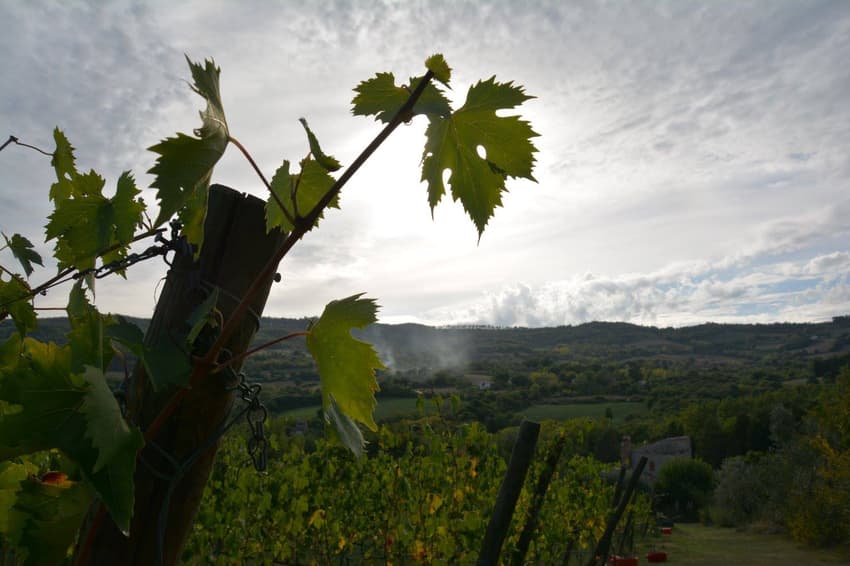
When life hands you grapes, you make wine. Writer John Henderson meets a Californian-Sicilian couple who found a vineyard near their Umbrian home and turned it into one of the region's most promising new wineries.
So you want to have a winery in Italy, huh? Sit on your porch looking out at your vineyard on the hill, sipping the fruits of your labour under a warm sun, a plate of pasta in front of you as the church bells peal from a nearby village?
Here’s one reality.
You’re in sleeping bags on the floor of an 800-year-old stone house with no electricity, heat or water. It takes you seven years to get a building permit. You realize that your land really isn’t your land. You have no money and take equipment from strangers on the promise you’ll pay them later. How? Who knows?
“With little money and just lots of work, you struggle but you know what? The truth is, we didn’t start off with this dream. We started off with an idea. That has turned into, honestly, a dream life.”
This sage advice comes from one Ev Thomas, a 69-year-old American artist who indeed is living the dream of many bored, overworked Americans with a fine taste for wine. Along with his Sicilian wife, Claudia Rizza, we’re sitting in the living room of his stone house at their Terramante winery in Umbria.
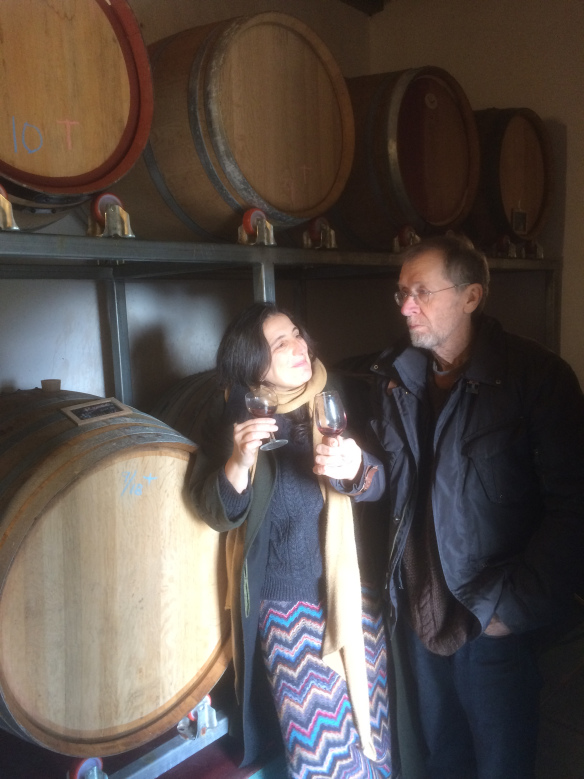
Ev Thomas and Claudia Rizza of Terramante. Photo: John Henderson
I’ve always called Umbria 'Tuscany Light'. It has all the things Tuscany has but with a fraction of the tourists and lower prices. Umbria is the only one of Italy’s 21 regions that does not border a sea or another country. Of all the regions with histories stretching back millennia, Umbria may be the least influenced by outsiders.
The biggest influence remains a humble saint. "Francesco" Giovanni di Pietro di Bernardone, better known as St Francis of Assisi, was a wealthy, carousing son of a rich cloth merchant and a French noblewoman. After military expeditions, a year as a prisoner and a bad illness, a holy vision changed his life forever. He tossed away his gold then spent his life helping the poor and living in a cave.
Now enter Ev and Claudia, living in what amounted to a cave. What they discovered is neighbours and Umbrians farther afield who went out of their way to make their idea come to fruition.
“In the US you could never do this,” says Thomas. “You never could. You have to understand that this zone is unique. The Umbrians in this area are still connected deeply with St Francis and the mentality of St Francis.
“It’s beautiful. And it’s one of the reasons I like it so much.”
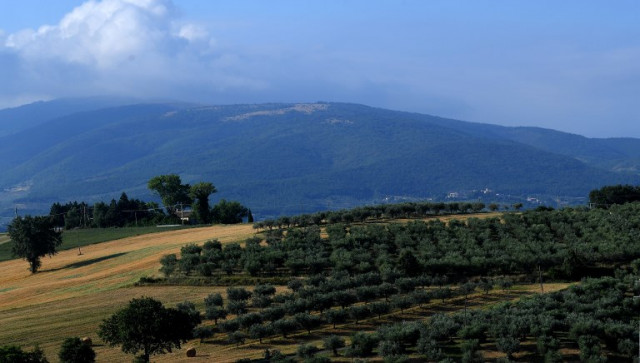
The Umbrian countryside. Photo: Tiziana Fabi/AFP
This story began in 1997. Thomas, raised in Chicago, had gone to San Francisco at age 25. Working as an artist and part-time at an art gallery, he met Claudia in ‘97 at a museum event. They eventually moved to her native Marsala, Sicily, where Thomas continued to make and sell art. However, in 2004 he wanted someplace closer to Rome, which he loves and has an airport for convenient shipping.
“We took a compass and drew a circle around Rome,” Thomas says. “We just started round the perimeter of Rome and out and out and out until we found something we could afford. We didn’t have much money. We couldn’t find anything and we were getting kind of desperate.”
READ ALSO: What's wrong with the Italian property market?
They arrived in Todi, a charming collection of stone houses, palaces and lightly trodden windy alleys on a hill 35 miles south of Assisi. The locals, unlike Californians, were encouraging them to stay. They found this house. Then they learned the price.
“We said, ‘Oh, well, there’s no point then. We can’t afford this place,’” Thomas says. “They said, ‘No! Just make the family an offer because you never know.’”
They offered what they could afford — two-thirds less. The owner didn’t laugh. He didn’t explode. He agreed. But then there was the matter of the geometra (surveyor), the pseudo real estate agent who helped them find the place.
“They get a percentage,” Rizza says. “We were short 500 euros. We said, ‘We’re going to buy but you’re going to have to cut your fee.’ And he did. We had no excuses. He agreed so now we have to buy the fucking place!”
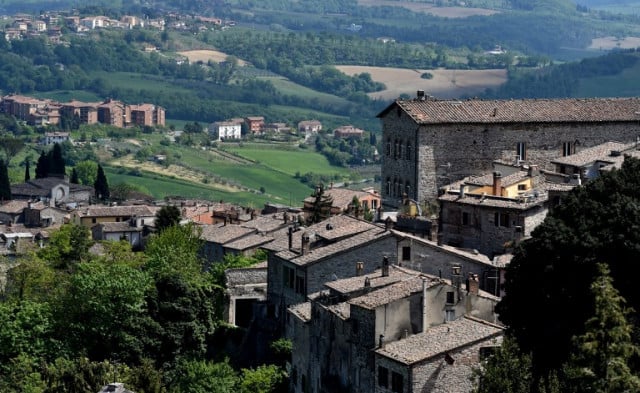
A view over Todi. Photo: Tiziana Fabi/AFP
The home, located at the end of a long dirt road on a hill on Todi’s outskirts, was once a tiny fortress and still sports the three-story stone tower used as a lookout for marauding armies in the 13th century. At the time of purchase it looked as if it hadn’t been refurbished since then, either.
What is now the dining room was outside. They lived in the tower and what is now the living room. They slept on the floor the first night. It was February and their lone heat was each other’s bodies.
“It was kind of a hole,” Rizza says.
They returned to Sicily to regroup and came back in the summer. Then the good samaritan Umbrians offered help. The couple met a “crazy” builder fishing on the neighbouring Tiber. Italo, “Mr Italy” as Thomas calls him, rarely wore shoes and walked with the gait of Johnny Depp in Pirates of the Caribbean. But he was pretty handy and offered to fix the entire house to their liking for €10,000. They borrowed the money from Rizza’s brother and Italo moved in.
READ ALSO: Finding a home in the Italian countryside: a survivors' guide
Italo noticed an old vineyard nearby, a throw-in during the purchase. He asked if he could take the grapes. Sure, they said, why not? They weren’t going to do anything with them. What did they know about making wine?
“The next spring I came up to check on things and he was here,” Thomas says. “We agreed to meet, He said, ‘Oh, you’ve got to try the wine!’
“‘What, the wine is ready already?’”
“‘Oh, yeah! It’s much better this way. It’s fresh.’”
“Oh, it was the worst wine I’ve ever tasted,” Thomas tells me. “But I couldn’t tell him this. When I went back home to Sicily, I told Claudia, ‘Jesus, that was the worst wine I’ve ever had. We can make better wine than that.’ So we started making plans.”
Thomas dug into research like he’d soon dig into the soil to plant vines. He connected with friends in the California wine industry for advice. He went to California to take weekend classes.
They returned to Umbria popping their corks about someday popping real corks. Then they ran into the biggest roadblock, bigger than money or weather or vine disease: Italy’s bureaucratic red tape.
Turns out, landowners own only one metre of land underneath the surface. In Umbria, which has very strict rules for planting grapes, you must buy the rights to plant and then wait for permission before planting vines. For an American, that’s as foreign a concept as the Italian language.
“He was like, ‘This is my land!’” Rizza says. “‘And I do whatever I want to with my land!’
“‘No you can’t.’”
“‘You and your stupid Italian mentality! You’ll never go anywhere!’
“He was planting and I was chasing after him to comply with everything.”
READ ALSO: 'The lessons we've learned from 10 years running a business in rural Italy'
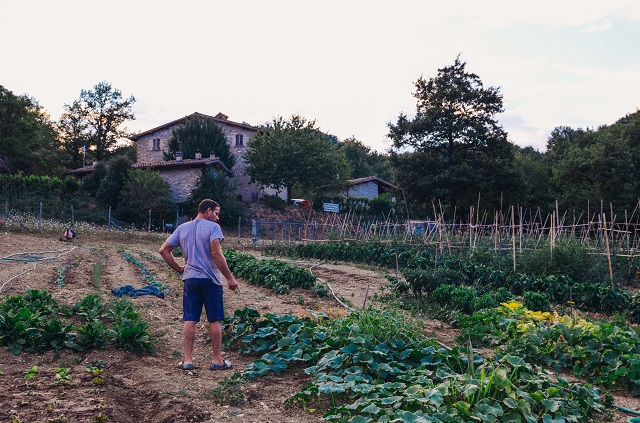
Photo: Ashley Bartner
The couple are laughing now. The red tape and labour and worries seem a lifetime ago.
“You have to go through somersaults,” Rizza says. “We did it the first portion because we planted a half hectare at a time. We decided to put up the money ourselves just so we didn’t have to go through the bureaucracy.”
Expansion and equipment were other matters. They applied for a building permit in 2008 and didn’t receive it until 2015, and they had to rebuild the living room and veranda area.
Equipment for making wine? What equipment? Where would they find it? Where would they get the money? Turns out they had a neighbour named Fabrizio who sold farm equipment. He had a duster. It cost €1,500. They didn’t have €1,500. Fabrizio said, “OK, I trust you guys. Don’t you worry. Take the duster. Pay me when you can.”
They later bought a sprayer from him and every month, the couple paid him a little bit, borrowing money from Rizza’s mother, using Thomas’ pension, with Rizza selling some ceramics and working at a B&B.
In 2007, they were ready to make wine. Again, the neighbours came to help. Three jovial elderly men came by to help collect the grapes. They brought a plastic vat that was bigger than the Fiat Panda it rode upon and dragging a destemmer behind it. All five went to work.
“They’re really old guys,” Thomas says. “They’re between 85 and 90. But they’re spry and smoking cigarettes like fiends. By the end of the night, after doing all this stuff and getting it into the vat, I never had so much fun in my life. I laughed so hard because these guys were great. They loved life.
“That got me hooked.”
Thomas made two barrels of what he thought were two pretty good wines, made with 100 percent Sangiovese grapes. Terramante, a combination of the Italian words “terra” (land) and “amante” (lover), was born.
So were Iubelo and Laudatus, his two wines named with local ties. Iubelo was the name of a poem written by Umbrian friar Jacopone da Todi, who following St Francis’ lead, gave away all his possessions. Laudatus, a Sangiovese-Sagrantino blend, comes from a Latin word, laudato, which means “praised” and is all through St Francis’ religious song, Canticle of the Sun.
Cute names, but the true test was taking it to California where his friends would judge.
“They said, ‘This is great wine. You should actually try to sell this stuff,’” Thomas says. “‘You should really think about making wine.’”
He only had five rows of grapes but little by little the plot grew. He now has five acres and through 12 years of trial and error, has produced a wine that is starting to sell and get recognition.
One Belgian passing by loved the wine and bought a couple of cases. What Thomas and Rizza didn’t know was that man’s wine club was voted as the best wine-tasting club in Europe. The club returned and bought 50 cases more. Then wine writer Jane Hunt liked the Iubelo and asked Decanter magazine to consider it for its list of top 100 wines in the world under €50 for 2017.
We get in their car and go farther up the hill to their winery. The three-story stone building overlooks the gorgeous green Umbrian valley. The farmland is partitioned off like a quilt with olive orchards on top, vineyards in the middle and grains and sunflower plantings in the bottom.
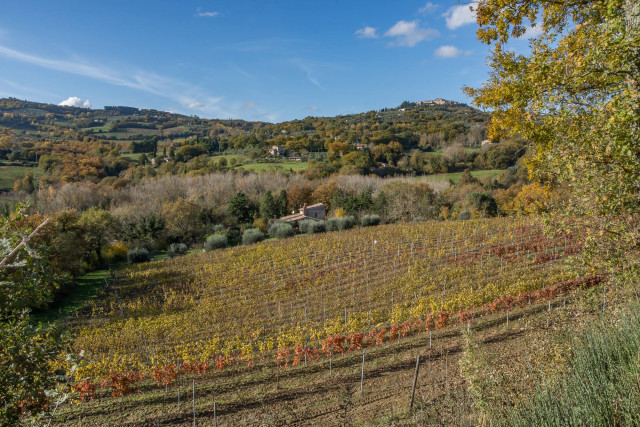
The vineyard in November 2018. Photo: Cantina Terramante/Facebook
Beauty isn’t the only advantage an Italian winery has over California. No, the biggest reason is economics. The California wine scene has gone corporate. You don’t find wineries in former friars' quarters.
“What is happening in California, particularly in the Napa Valley, is land values have gone up tremendously,” Thomas says. “In part this is a result of large international investors as well as, in some cases, personalities. Multimillionaires who go in and buy something because it’s always been their dream to have a winery.”
Thomas says an acre of land in California goes for between $250,000-$750,000, or around €219,000-€656,000. In Umbria land goes for about €3,500-€4,400 an acre and in Tuscany, except for the over-the-top Bolgheri region, it’s about €26,000.
Thomas and Rizza don’t have aspirations of getting rich. They hope to break even next year and maybe if they acquire more land some day they’ll make a profit.
They should. I was never a huge Sangiovese fan. But his Iubelo is the best Sangiovese I’ve ever had. It’s rich with clean acidity and a bushel of red fruit.
“Sangiovese, when you take it into your mouth and it’s the right temperature,” Thomas says, “it has this quality of blood.”
Now that he’s up to his taste buds in Italian grapes, he may become the touchstone for Americans with similar ambitions of starting a winery in Umbria. I ask him what advice he’d give.
“Decide what part of Italy,” he says. “Take some time. Drive around Italy. Make sure this region is what you’re interested in. What does this region have to offer you that fits into what’s important to you?
“Maybe the Piemonte is more you. Maybe Puglia is for you. Then of course, are you an urban person or are you a rural person? Very basic life decisions like that to begin with.”
Living in Italy I’ve noticed some of the happiest people living here are wine people. I can see why. They’re outside in beautiful country. The weather often reminds them of heaven. They’re making a product that is not only delicious but healthy. They meet interesting like-minded people.
As Rizza quotes St Francis:
“If you work with your hands you are a worker. If you work with your hands and your head you are an artisan. And if you work with your hands, your head and your heart you are an artist.”
Salute.
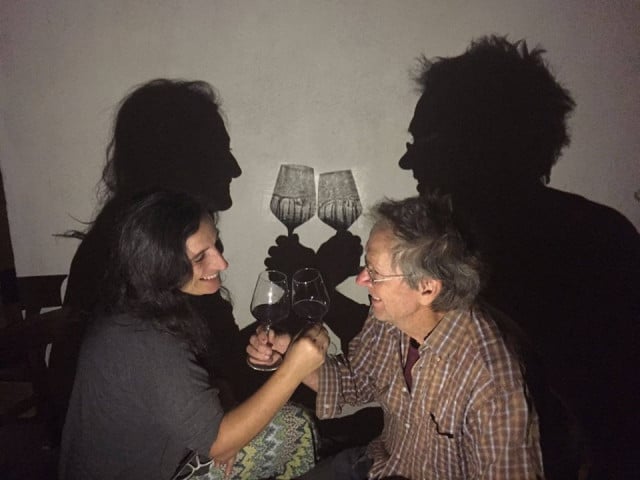 Photo: Cantina Terramante/Facebook
Photo: Cantina Terramante/Facebook
John Henderson is an American writer living in Rome. This is an edited version of an article that was originally published on his blog, Dog-Eared Passport. Find more of his stories here.
Want to write a guest blog for The Local Italy? Get in touch at [email protected].
Comments
See Also
So you want to have a winery in Italy, huh? Sit on your porch looking out at your vineyard on the hill, sipping the fruits of your labour under a warm sun, a plate of pasta in front of you as the church bells peal from a nearby village?
Here’s one reality.
You’re in sleeping bags on the floor of an 800-year-old stone house with no electricity, heat or water. It takes you seven years to get a building permit. You realize that your land really isn’t your land. You have no money and take equipment from strangers on the promise you’ll pay them later. How? Who knows?
“With little money and just lots of work, you struggle but you know what? The truth is, we didn’t start off with this dream. We started off with an idea. That has turned into, honestly, a dream life.”
This sage advice comes from one Ev Thomas, a 69-year-old American artist who indeed is living the dream of many bored, overworked Americans with a fine taste for wine. Along with his Sicilian wife, Claudia Rizza, we’re sitting in the living room of his stone house at their Terramante winery in Umbria.

Ev Thomas and Claudia Rizza of Terramante. Photo: John Henderson
I’ve always called Umbria 'Tuscany Light'. It has all the things Tuscany has but with a fraction of the tourists and lower prices. Umbria is the only one of Italy’s 21 regions that does not border a sea or another country. Of all the regions with histories stretching back millennia, Umbria may be the least influenced by outsiders.
The biggest influence remains a humble saint. "Francesco" Giovanni di Pietro di Bernardone, better known as St Francis of Assisi, was a wealthy, carousing son of a rich cloth merchant and a French noblewoman. After military expeditions, a year as a prisoner and a bad illness, a holy vision changed his life forever. He tossed away his gold then spent his life helping the poor and living in a cave.
Now enter Ev and Claudia, living in what amounted to a cave. What they discovered is neighbours and Umbrians farther afield who went out of their way to make their idea come to fruition.
“In the US you could never do this,” says Thomas. “You never could. You have to understand that this zone is unique. The Umbrians in this area are still connected deeply with St Francis and the mentality of St Francis.
“It’s beautiful. And it’s one of the reasons I like it so much.”

The Umbrian countryside. Photo: Tiziana Fabi/AFP
This story began in 1997. Thomas, raised in Chicago, had gone to San Francisco at age 25. Working as an artist and part-time at an art gallery, he met Claudia in ‘97 at a museum event. They eventually moved to her native Marsala, Sicily, where Thomas continued to make and sell art. However, in 2004 he wanted someplace closer to Rome, which he loves and has an airport for convenient shipping.
“We took a compass and drew a circle around Rome,” Thomas says. “We just started round the perimeter of Rome and out and out and out until we found something we could afford. We didn’t have much money. We couldn’t find anything and we were getting kind of desperate.”
READ ALSO: What's wrong with the Italian property market?
They arrived in Todi, a charming collection of stone houses, palaces and lightly trodden windy alleys on a hill 35 miles south of Assisi. The locals, unlike Californians, were encouraging them to stay. They found this house. Then they learned the price.
“We said, ‘Oh, well, there’s no point then. We can’t afford this place,’” Thomas says. “They said, ‘No! Just make the family an offer because you never know.’”
They offered what they could afford — two-thirds less. The owner didn’t laugh. He didn’t explode. He agreed. But then there was the matter of the geometra (surveyor), the pseudo real estate agent who helped them find the place.
“They get a percentage,” Rizza says. “We were short 500 euros. We said, ‘We’re going to buy but you’re going to have to cut your fee.’ And he did. We had no excuses. He agreed so now we have to buy the fucking place!”

A view over Todi. Photo: Tiziana Fabi/AFP
The home, located at the end of a long dirt road on a hill on Todi’s outskirts, was once a tiny fortress and still sports the three-story stone tower used as a lookout for marauding armies in the 13th century. At the time of purchase it looked as if it hadn’t been refurbished since then, either.
What is now the dining room was outside. They lived in the tower and what is now the living room. They slept on the floor the first night. It was February and their lone heat was each other’s bodies.
“It was kind of a hole,” Rizza says.
They returned to Sicily to regroup and came back in the summer. Then the good samaritan Umbrians offered help. The couple met a “crazy” builder fishing on the neighbouring Tiber. Italo, “Mr Italy” as Thomas calls him, rarely wore shoes and walked with the gait of Johnny Depp in Pirates of the Caribbean. But he was pretty handy and offered to fix the entire house to their liking for €10,000. They borrowed the money from Rizza’s brother and Italo moved in.
READ ALSO: Finding a home in the Italian countryside: a survivors' guide
Italo noticed an old vineyard nearby, a throw-in during the purchase. He asked if he could take the grapes. Sure, they said, why not? They weren’t going to do anything with them. What did they know about making wine?
“The next spring I came up to check on things and he was here,” Thomas says. “We agreed to meet, He said, ‘Oh, you’ve got to try the wine!’
“‘What, the wine is ready already?’”
“‘Oh, yeah! It’s much better this way. It’s fresh.’”
“Oh, it was the worst wine I’ve ever tasted,” Thomas tells me. “But I couldn’t tell him this. When I went back home to Sicily, I told Claudia, ‘Jesus, that was the worst wine I’ve ever had. We can make better wine than that.’ So we started making plans.”
Thomas dug into research like he’d soon dig into the soil to plant vines. He connected with friends in the California wine industry for advice. He went to California to take weekend classes.
They returned to Umbria popping their corks about someday popping real corks. Then they ran into the biggest roadblock, bigger than money or weather or vine disease: Italy’s bureaucratic red tape.
Turns out, landowners own only one metre of land underneath the surface. In Umbria, which has very strict rules for planting grapes, you must buy the rights to plant and then wait for permission before planting vines. For an American, that’s as foreign a concept as the Italian language.
“He was like, ‘This is my land!’” Rizza says. “‘And I do whatever I want to with my land!’
“‘No you can’t.’”
“‘You and your stupid Italian mentality! You’ll never go anywhere!’
“He was planting and I was chasing after him to comply with everything.”
READ ALSO: 'The lessons we've learned from 10 years running a business in rural Italy'

Photo: Ashley Bartner
The couple are laughing now. The red tape and labour and worries seem a lifetime ago.
“You have to go through somersaults,” Rizza says. “We did it the first portion because we planted a half hectare at a time. We decided to put up the money ourselves just so we didn’t have to go through the bureaucracy.”
Expansion and equipment were other matters. They applied for a building permit in 2008 and didn’t receive it until 2015, and they had to rebuild the living room and veranda area.
Equipment for making wine? What equipment? Where would they find it? Where would they get the money? Turns out they had a neighbour named Fabrizio who sold farm equipment. He had a duster. It cost €1,500. They didn’t have €1,500. Fabrizio said, “OK, I trust you guys. Don’t you worry. Take the duster. Pay me when you can.”
They later bought a sprayer from him and every month, the couple paid him a little bit, borrowing money from Rizza’s mother, using Thomas’ pension, with Rizza selling some ceramics and working at a B&B.
In 2007, they were ready to make wine. Again, the neighbours came to help. Three jovial elderly men came by to help collect the grapes. They brought a plastic vat that was bigger than the Fiat Panda it rode upon and dragging a destemmer behind it. All five went to work.
“They’re really old guys,” Thomas says. “They’re between 85 and 90. But they’re spry and smoking cigarettes like fiends. By the end of the night, after doing all this stuff and getting it into the vat, I never had so much fun in my life. I laughed so hard because these guys were great. They loved life.
“That got me hooked.”
Thomas made two barrels of what he thought were two pretty good wines, made with 100 percent Sangiovese grapes. Terramante, a combination of the Italian words “terra” (land) and “amante” (lover), was born.
So were Iubelo and Laudatus, his two wines named with local ties. Iubelo was the name of a poem written by Umbrian friar Jacopone da Todi, who following St Francis’ lead, gave away all his possessions. Laudatus, a Sangiovese-Sagrantino blend, comes from a Latin word, laudato, which means “praised” and is all through St Francis’ religious song, Canticle of the Sun.
Cute names, but the true test was taking it to California where his friends would judge.
“They said, ‘This is great wine. You should actually try to sell this stuff,’” Thomas says. “‘You should really think about making wine.’”
He only had five rows of grapes but little by little the plot grew. He now has five acres and through 12 years of trial and error, has produced a wine that is starting to sell and get recognition.
One Belgian passing by loved the wine and bought a couple of cases. What Thomas and Rizza didn’t know was that man’s wine club was voted as the best wine-tasting club in Europe. The club returned and bought 50 cases more. Then wine writer Jane Hunt liked the Iubelo and asked Decanter magazine to consider it for its list of top 100 wines in the world under €50 for 2017.
We get in their car and go farther up the hill to their winery. The three-story stone building overlooks the gorgeous green Umbrian valley. The farmland is partitioned off like a quilt with olive orchards on top, vineyards in the middle and grains and sunflower plantings in the bottom.

The vineyard in November 2018. Photo: Cantina Terramante/Facebook
Beauty isn’t the only advantage an Italian winery has over California. No, the biggest reason is economics. The California wine scene has gone corporate. You don’t find wineries in former friars' quarters.
“What is happening in California, particularly in the Napa Valley, is land values have gone up tremendously,” Thomas says. “In part this is a result of large international investors as well as, in some cases, personalities. Multimillionaires who go in and buy something because it’s always been their dream to have a winery.”
Thomas says an acre of land in California goes for between $250,000-$750,000, or around €219,000-€656,000. In Umbria land goes for about €3,500-€4,400 an acre and in Tuscany, except for the over-the-top Bolgheri region, it’s about €26,000.
Thomas and Rizza don’t have aspirations of getting rich. They hope to break even next year and maybe if they acquire more land some day they’ll make a profit.
They should. I was never a huge Sangiovese fan. But his Iubelo is the best Sangiovese I’ve ever had. It’s rich with clean acidity and a bushel of red fruit.
“Sangiovese, when you take it into your mouth and it’s the right temperature,” Thomas says, “it has this quality of blood.”
Now that he’s up to his taste buds in Italian grapes, he may become the touchstone for Americans with similar ambitions of starting a winery in Umbria. I ask him what advice he’d give.
“Decide what part of Italy,” he says. “Take some time. Drive around Italy. Make sure this region is what you’re interested in. What does this region have to offer you that fits into what’s important to you?
“Maybe the Piemonte is more you. Maybe Puglia is for you. Then of course, are you an urban person or are you a rural person? Very basic life decisions like that to begin with.”
Living in Italy I’ve noticed some of the happiest people living here are wine people. I can see why. They’re outside in beautiful country. The weather often reminds them of heaven. They’re making a product that is not only delicious but healthy. They meet interesting like-minded people.
As Rizza quotes St Francis:
“If you work with your hands you are a worker. If you work with your hands and your head you are an artisan. And if you work with your hands, your head and your heart you are an artist.”
Salute.
 Photo: Cantina Terramante/Facebook
Photo: Cantina Terramante/Facebook
John Henderson is an American writer living in Rome. This is an edited version of an article that was originally published on his blog, Dog-Eared Passport. Find more of his stories here.
Want to write a guest blog for The Local Italy? Get in touch at [email protected].
Join the conversation in our comments section below. Share your own views and experience and if you have a question or suggestion for our journalists then email us at [email protected].
Please keep comments civil, constructive and on topic – and make sure to read our terms of use before getting involved.
Please log in here to leave a comment.